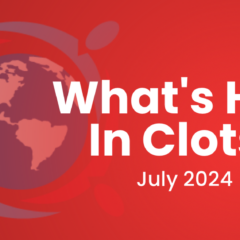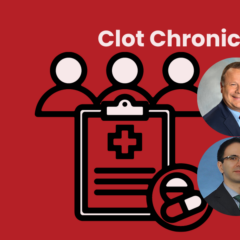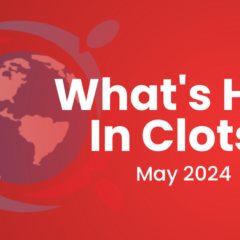Last updated on
Clot Chronicles: Trial Takeaways from ACC 2021
Hello, my name is Christian Ruff, and I’m here today to talk with you about ACC 2021 for NATF’s Clot Chronicles. We had an incredibly exciting virtual American College of Cardiology Conference this year with some great breaking science that really informs our clinical practice. I would like to start off with a few of the highlights from this year’s ACC.
First up is the ADAPTABLE trial, which studied low-dose aspirin versus higher-dose aspirin, so 81 mg versus 325 mg, for patients with ASCVD. We know that there has been this debate for a long time whether higher- versus lower-dose aspirin is more effective and which one is safer. And this was a big, real-world study randomizing approximately 15,000 patients who receive either 81 or 325 mg of aspirin. Most of the patients in this trial were on aspirin prior to randomization, usually the lower dose. Over about two years of follow-up, the rate of the composite outcome, which was all-cause mortality (ACM), MI, and stroke was actually similar between the two groups, as was the rate of major bleeding.
Now, there are some important caveats to this study. One is that 42% of the patients who were randomized to the higher-dose aspirin, the 325 mg, switched to the lower dose during the study. Approximately a lower percentage, 7%, switched from the lower dose to the higher dose. This is important because we’re not sure if the similar findings were due to the fact that many patients were switching from the higher dose to the lower dose during the trial. There were more patients on the lower dose than you would have expected at the start of the clinical trial.
I think there are some important messages, first that aspirin is effective for reducing atherosclerotic events. At least in this study, there doesn’t appear to be a benefit or a risk to either strategy, so both doses appear to be effective and safe. I think one of the problems of doing a real-world study, and this was using the large PCORI clinical trial network simplified pragmatic clinical trial. It’s a real success that the investigators were able to conduct this trial but one of the challenges of doing these practical, real-world studies is this issue of patients staying on the right dose. That may have limited the applicability of the findings, but nevertheless, a very important advance in our understanding of patients with atherosclerotic cardiovascular disease and their aspirin dose.
We’ll shift gears now to atrial fibrillation (AFib). There were a lot of exciting findings at this year’s ACC, one regarding left atrial appendage occlusion (LAAO) during cardiac surgery with respect to stroke risk from Afib. This was from the LAAOS III trial, and again, these were patients who were undergoing cardiac surgery. The investigators were studying whether in addition to whatever surgery these patients were having, whether they would get adjunctive LAAO. Approximately 4800 adults with a history of Afib who had a risk for stroke—so a CHA₂DS₂-VASc score ofc>2 or 2—were randomized to undergo or not undergo LAAO in cardiac surgery. Importantly, all patients continued to receive standard anticoagulation during the study for their Afib.
Surprisingly, the risk of stroke and systemic embolism was significantly reduced in those patients who had occlusion. There was approximately a 33% reduction in the risk of stroke with systemic embolism. I think that’s a very important advance, in that there does seem to be an additional benefit of having LAAO in addition to anticoagulation. Again, these are patients who were already undergoing cardiac surgery and the appendage occlusion was performed as part of the surgery.
Of course, what we don’t know is the benefit with respect to doing transcatheter-based LAAO. There are some important registry findings actually from a WATCHMAN registry that showed that transcatheter LAAO with a WATCHMAN device was associated with a low rate of stroke in older, high-risk patients at one year. Again, patients who undergo the transcatheter approach are often not on long-term anticoagulation. What we don’t know is whether a dual strategy for high-risk patients of both occluding the left atrial appendage as well as prescribing anticoagulation would be even more effective than either strategy alone.
There are some other really important studies that were presented as well. One has to do with how we treat patients with peripheral vascular disease. We know that patients with peripheral vascular disease are at a high risk of recurrent events, and we know from the VOYAGER PAD trial, which was actually presented last year and published at ACC 2020, that low-dose rivaroxaban 2.5 mg twice daily plus aspirin significantly reduced cardiovascular events, particularly vascular events, in patients with peripheral artery disease (PAD) – about a 15% reduction.
Now, this follow-up VOYAGER PAD study presented at this year’s ACC expands those findings to look at total events. We know that these patients are at very high risk for not just having a first event, but having other cardiac and lower extremity events. The study found that not only did they have more events, but the strategy of low-dose rivaroxaban plus aspirin reduced first events by about 14% and reduced total events by 14%. Again, a very consistent finding that these patients at high risk have multiple events, and that this strategy is effective in reducing these events.
I think an important thing to note is just the high risk of these patients – 60% of second events occurred in patients who had a first peripheral revascularization. We know in that patients with PAD who undergo lower extremity revascularization at very high rates, anticoagulation with low-dose rivaroxaban plus antiplatelet therapy with aspirin is effective – particularly in patients who’ve had prior peripheral revascularization and are at very high risk of having secondary events.
Another important study is with respect to how we approach patients with transcatheter aortic valve replacement (TAVR). We know that in patients without Afib, the standard approach to antithrombotic management in these patients is usually antiplatelet therapy. The ATLANTIS study investigated the optimal antithrombotic regimen following TAVR. In this study, patients were randomized to either apixaban or antiplatelet therapy, which was usually aspirin. Some of these patients also had an indication for anticoagulation, say for Afib. Those patients would remain on the anticoagulant (either apixaban or a vitamin K antagonist). In this study, interestingly there was no significant difference in the primary endpoint, which was a composite of death, stroke, heart attack, valve thrombosis, or pulmonary or systemic embolism. Apixaban appeared similar to antiplatelet therapy with respect to TAVR.
What does this tell us? Importantly, these aren’t patients with necessarily a guideline indication for anticoagulation and these results suggest that we don’t need to routinely default to apixaban or anticoagulation in general for the default antithrombotic treatment after successful TAVR. It has no real advantage over antiplatelet therapy. What was interesting in this study is that in a sub-study that looked at subclinical valve thrombosis based on 4D-CT, it looked like apixaban had an 80% lower rate of clot formation around the implanted valve compared to antiplatelet therapy. Interestingly, that didn’t translate into a clinical benefit in this trial. I think more work needs to be done to understand why this benefit in leaflet thrombosis doesn’t seem to translate to a clinical benefit with respect to hard endpoints.
Now, shifting gears a little bit to the era of the COVID pandemic, we had the INSPIRATION-S study. Now, we’re awaiting some of the definitive evidence regarding intermediate- or standard-dose prophylactic anticoagulation in critically ill patients with COVID. This is part of that trial design, but looked specifically at statin therapy, whether atorvastatin is beneficial in critically ill patients with COVID. Obviously, there was a lot of thought that atorvastatin might be beneficial. We know that statins are very helpful in reducing thrombotic events in high-risk patients, whether that’s MI or stroke or even venous thromboembolism, and we know that critically ill COVID patients have very high rates of both arterial and venous thrombosis.
This study included about 600 or so patients admitted to the ICU and looked at this composite outcome of arterial and venous thrombotic events, as well as progression to sort of advanced therapy such as extracorporeal membrane oxygenation. There was no difference in either the ischemic endpoints or major bleeding. It appears that at least with critically ill patients with COVID, atorvastatin therapy was not beneficial or harmful. Again, we don’t need to be thinking about statin therapy for the acute management of COVID. Of course, in patients who have an indication for statin therapy, there’s no reason to discontinue it when that patient is hospitalized in an ICU with COVID.
And finally, we did learn a little bit more about a topic all of us are interested in, and that’s the risk or benefit of alcohol with heart disease. We know that there’s been a debate with respect to say heart attacks, whether some moderate alcohol use is perhaps beneficial in reducing atherosclerotic cardiovascular events. There was an interesting study, HOLIDAY Monitors, which was looking at alcohol consumption and the risk of Afib in particular, specifically whether one glass of wine, beer, or any alcoholic beverage would increase the risk of Afib acutely within the first few hours of consumption.
The study looked at 100 patients with either paroxysmal or intermittent Afib who had consumed at least one alcoholic beverage in the last month. These patients wore an ECG monitor to continuously track their heart rhythm and also wore a transdermal alcohol sensor on their ankle to detect if they consumed multiple drinks. They would press the button on the heart monitor when they had an alcoholic drink – a very sort of sophisticated study design. Interestingly, the study showed (somewhat surprisingly) that even one alcoholic beverage was associated with a 2-fold greater risk of having Afib within the next four hours. There was a dose effect, too. If you had two or more drinks in one sitting there was more than a 3-fold risk of Afib.
So, while I still think that there is a healthy debate whether moderate alcohol consumption—one drink in women, one to two drinks in men daily—may have some beneficial cardiovascular effects with respect to atherosclerotic cardiovascular disease. However, this study seems to show that any alcohol is associated with a significantly increased risk of having an episode of Afib. Again, very thought provoking and certainly some food for thought that needs further validation in larger studies – but very important to understanding Afib and lifestyle.
This was really just a snapshot of some of the incredible science and late-breaking clinical trials of this year’s ACC. I’m very excited to share these trials with you and look forward to the next update with major late-breaking science.



